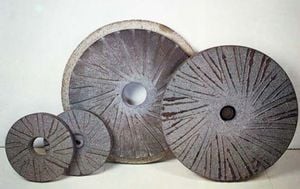
Unlike the shelling which is a procedure that is different for each grain, the milling process is the same with all grains. Only the machine settings differ.
Besides the traditional methods (using mortar and pestle, grinding wheel) that are still used in rural Africa, small mills have appeared in the cities, and then in the villages.
This section deals with the general aspects of the milling technique, and presents the different non-industrial technical solutions adapted to rural and urban zones in developing countries.
The products of the milling[edit | edit source]
Cereals are the basis for many dishes, specific to each region: couscous, tortillas, dumplings, ... The flour, meal and breaked rice resulting from the grinding and milling and sometimes a fermentation of the hulled grains. It is in these forms that grains are used in cooking, it is indeed very unusual to see one consume whole grains, except in the case of rice.
The particle size The milled products are distinguished by the fineness of the particles: the particle size.
For the best quality flour, the particle size is less than 0.2 mm; for flour "for rolling" or for "couscous" flour, the size varies from 0.2 to 0.7 mm; for meal between 0.7 and 1 mm; for thin broken maize between 1 to 1.5 mm; for average broken grain from 1.5 to 2.5 mm, and finally, the large broken grains are smaller than 2.5 mm. These products are obtained in most cases by a dry process and present a low final moisture content (below 10%) that ensures a long shelf life.
In industrial milling installations, the grains are ground in several stages, the fine, medium and large particles are separated using a sieve in each stage. The same thing happens in the traditional grinding by pestle, where the grinded matter repeatedly passes through a sieve. Thus, only large particles continue being crushed. Regarding the mills described here, a high degree of grinding is generally obtained by several passings in the mill, but without sieving.
For a general assessment on the fineness of the grinded matter of a mill or on the grinding process we need a certain method for measuring, because flowers are not homogeneous. They are indeed made of particles of different sizes (an average meal produced by a "simple" mill or by a traditional process, has 80% (by mass) of the particles having a size ranging between 0.1 and 1 mm).
Image 7 describes the used measuring method in determining the flour smoothness index: a series of standard sieves separate the mixture into five classes of particles. Their share of the total mass (eg 100 grams) of the sample is multiplied by the weight factor. The sum of the five results constitutes the index of smoothness.
The higher the smoothness index, the lesser the flour is fine. The common flour fineness in Africa is between 1 and 2.
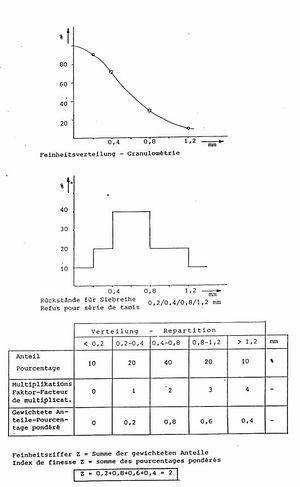
Various uses depending on country The flour is usually used for the manufacturing of porridge ("rouy" in Senegal) or paste ("tô" in Burkina Faso). It is sometimes used for the home preparation of rolled products such as couscous, but the low humidity often makes this difficult.
Broken rice or finely broken millet, sorghum or maize is used for the preparation of dumplings. It can also be used for certain dishes: meal cooked in a vegetable and fish broth, steamed meal served with a sauce, ...
Broken maize is also used for the preparation of dumplings and salted dishes inspired on rice dishes. They are also sold to breweries.
Wet or dry flour ? The grain moisture, and thus the flour, plays an important role in its shelf life, in the choice of the grinding equipment, and the taste of the finished product.
The drier a flour is, the better it keeps. The tolerable limit of humidity is 16%. The meal prepared by the African women with hulled millet with the pestle and mortar (ie wetted), only keeps for one or two days, and then fermented unless the grain has been dried after the shelling. This wet grain, which is made by the women grinders, has a slightly fermented charisteristic and it is a popular flour in Africa.
The mill must be chosen according to this constraint (not all models are capable of grinding wet grain), or we must insert an extra drying step between wet and dry milling. Seeing that the women frequently use grinders, this change in traditional practices does not appear to be a constraint.
Other quality criteria The quantity of brans and impurities in the flour is also a criterion of quality. Some traditional African dishes can tolerate a meal with a bit of brans, however other dishes, like certain dumplings or the manufacturing of traditional pastes require very pure flour.
The quality of the vitamins and proteins in the flour is also an important criterion, especially for the manufacturing of children flours whose nutritional value and composition should be correctly determined.
Of these, two books are particularly recommended: " Transformer les céréales pour les nouveaux marchés urbains, Broutin Cécile, Collection Le Point Sur AGRIDOC & GRET, Paris, France, 2003, 296 p. ISBN : 2-86844-142-4"; and "Précis technique sur les farines composées, application des techniques existantes, available on-line at: http://web.archive.org/web/20190205200642/http://www.fao.org:80/Wairdocs/X5033F/X5033f00.htm
Traditional methods of grinding grain.[edit | edit source]
The milling is one of the oldest cultural techniques of humanity. All civilizations that feed more or less exclusively from cereals were forced to develop technologies for grinding the grains of grain crops. In all traditional civilizations, grinding is the domain of women.
There are two different techniques:
- The grinding done by beating the grain (mortar and pestle)
- The grinding done by rubbing the grains between two stones (wheel mill)
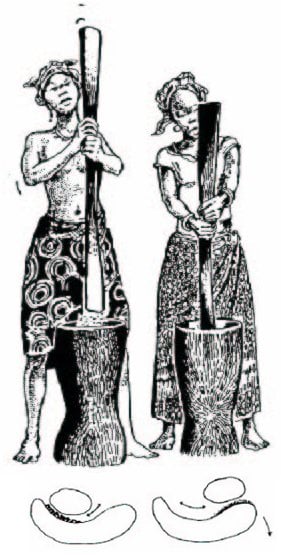
The method of mortar and pestle is the most widely used in the West-African countryside. Before grinding, women usually soak the seeds, and then let them either sit overnight or for several hours in the sun, which allows the homogenization of the moisture inside the grains.
During the milling, the pounding mortar is interrupted by several sievings that allow to obtain a range of different products, from meal the the most fine flours. The advantage of this method is its versatility: The woman totally controls the operation, so that she can adapt according to the requirements and the available available.
The flour thus obtained contains between 22 and 26% water. Its rapid fermentation, appreciated in the culinary preparations, will not permit storage beyond one or two days. When the women change from this grinding by mortar and pestle to the dry grinding with the mill, they must learn to dry the grain after the shelling, and use less fermented flour, or ferment the flour by moistening it after milling it.
The pounding work is demanding and tiring. In Senegal, we calculated an average daily efficiency of 4 kg/h per woman (see Table 2), which is an order of magnitude. Knowing that a woman grinds approximately 4 to 6 kg of grain per day, this hard work will take her more than one hour of pounding per day. This quick calculation helps explains the success of the motorised mill. Even if women do not necessarily win a lot of time (given the transportation time, waiting, ...), they at least have a significant reduction in workdifficulty. They have to provide more intense physical effort to grind their daily grain.
| Maize | Millet | Sorghum | |
| Moisture contence | 24.5 | 25.8 | 23.2 |
| Weight (for a mositure contence of 10%) | 1805 g | 1820 g | 1785 g |
| Spend time grinding | 18.32 min | 14.43 min | 22.17 min |
| Spend time sieving | 12.67 min | 10.03 min | 14.90 min |
| Effiency | 3.5 kg/h | 4.5 kg/h | 2.9 kg/h |
| Fineness index[1] | 1.4 | 1.4 | 1.35 |
Table 2: Expenditure of time milling of sorghum, millet and maize, with mortar and pestle (Bamako, Mali) after Evaluation et choix de moulins, by Peter Löwe et Jean-Max Baumer, Rapport de mission pour APICA, mars 1986, 50 p.</ref> and Vanek, KV Small Scale Grain and Grinding Dehulling in Mali, FAO 1981.
The method of the wheel mill (original of Neolithic period) uses a flat stone slab and also a grinding stone. The wheel, operated by hand, is used to grind grains that are deposited on the slab. Two to three passes of the wheel is enough to get a coarse meal that falls gradually from the slab. It is a method that is still used in the rural areas of East Africa. The average yield of this method is 1.5 to 2 kg/h (after Evaluation et choix de moulins, by Peter Löwe et Jean-Max Baumer, Rapport de mission pour APICA, mars 1986, 50 p.).
Milling with the mills[edit | edit source]
Besides these traditional technologies that are still widespread in the African rural areas, small mills have emerged in towns and villages. Two major types of mills, functioning on different principles, divide the market: the wheel mills and hammer mills.
The wheel mills[edit | edit source]
There are several types of motorisation available, each corresponding to a different type of mill: manual mill, animal traction, motor and even water.
A. Principle of operation The principle of operation of these mills are the grinding of the grain by crushing it between two abrasive surfaces: the wheels. They consist of a fixed wheel and a mobile wheel turning upon the first in a horizontal or vertical plain (see image 9: horizontal wheel mill, and image 10: vertical wheel mill). The two wheels of the machine are identical regarding material and dimensions.
The grain is poured into a conical or pyramidal hopper. A supply valve located at the base of the hopper is used to regulate the flow of grain. It flows into the grinding chamber through the center of one of the wheels of which the axial portion is hollow. The grinding of the grain is done in the traject that is does between the two wheels, from the center to the periphery.
The horizontal and vertical wheel mills give different results. Indeed, in the case of horizontal wheel mills, the grain is gradually led to the periphery during the milling, guided by the splines of the wheel under the effect of the centrifugal force alone. In the case of the vertical wheel mills, the grain undergoes the effect of its weight more, which pulls it down, ie towards the periphery of the wheel. It has a shorter passage time, which results in a less regular flour with the horizontal millstones.
However, the manufacturing of horizontal wheel mills is more complex because it requires an angle in the transmission for installation of a thermal engine. The cost of this package is large. The maintenance opening, the access to the interior and the dismantling of the horizontal wheels are also complex. Therefore mills with vertical wheels are much more prevalent, the construction of horizontal wheel mills is only justified with large wheels (with a diameter exceeding 500 mm) of which the weight can only be supported by a horizontal axis, or for very small domestic mills.
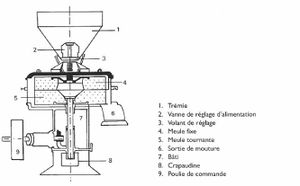
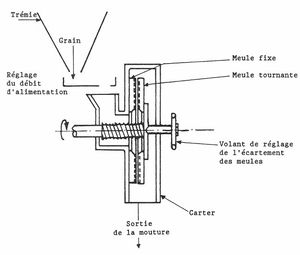
B. The wheels
Used materials The principal parts of these mills are crushing wheels. The materials used for manufacturing these are of different nature. There are two main types of wheels, their choice is based on our purpose and the price can be paid on them:
- Metal wheels: These mills are also known by the name "disk mill" or "plate mill"; plates are cast iron or "fonte acieré". They are very strong, inexpensive and can grind a wide variety of dry or slightly damp products (cereals, peanuts, shea nuts,...). However, there is a risk of heating of the flour, and it takes the wheel two passes if we want a fine flour.
- Stone wheels: among these we distinguish:
- natural stone wheel mills, these are generally made from a blend of siliceous rocks close to quartz, and are found in a quarry (sometimes called flint stone wheels). There are also granite or volcanic basalt wheels cut ou of a rockformation.
- abrasive particles wheels (natural or artificial) agglomerated with a oxychloride magnesium cement. The abrasive is generally a synthetic corundum, very hard material. Other wheels are made from natural corundum, the naxos, stone originating from Greece or Turkey.
The wear of the wheels does not deprive them of their abrasive properties, since new edges always appear at the surface. Because of the weight and difficulty to place them in a vertical position, the large diameter wheels (from 60 cm diameter) are often arranged horizontally.
Table 3 summarizes the advantages and disadvantages of the main wheel types.
| Material | Advantages | Disadvantages |
| Metal | great solidity, high trougput, reduced cost to the purchase and replacement, resharpenable | May increase the temperature while milling, lower fineness of milling than with corundum mills |
| Vitrified corundum | Strong, lighter than metal, relatively insensitive to atmospheric conditions, fine grinding, resharpenable | high cost, only well dried grains |
| Natural stone | Solid, large abrasive surface, fine grinding | Quite heavy, only well dried grains |
Table 3: Advantages and disadvantages of the main materials used for grinding.
A studied assembling The assembling of a grinding wheel consists of fitting its working surface with a series of rays, of which the numbers, shapes and sizes depend on the nature of the grain to grind and the level of desired fineness. The rays split the beans on all of the working surface and ensure the cooling of the mill and flour (see image 11 and 12). Variations in shape and arrangement of rays are innumerable. Some of the most common types are shown in image 11.

The pulversing of the grain is done by the rebate or smooth part of the mill, which is generally pitted or cracked to provide a more efficient milling. Too much rabbet surface can be a source of heating. Generally, the greater the number of rays, the colder the grinding is and the greater the flow is.
The assembling of corundum wheels, or the resharpening of the cast iron wheels consists of fixing the grooves, when the friction is too blunt. The wheels must be sharpened after approximately every five tonnes of milled grain.
The settings These must be precise. Indeed, the gauge of the wheels determine the fineness of the flour. The fineness setting is reglated by the tightening of the wheels via a steering wheel: the more the wheels are pressed together, the finer the flour is, but the more the throughput decreases.
A security spring system ensures that the wheels are not damaged by the accidental passage of a foreign body (pebbles, nickles,...). A lever can also used to disassemble the wheels for removing the remaining flour between the wheels, after a long period of grinding. It is therefore essential to adjust the spacing according to the grain to grind. In particular, we must avoid to grind grains of different diameters (millet and maize, for example) without changing the settings. Incorrect wheel spacing can cause:
- an incomplete milling,
- the formation of a paste that sticks to the wheels and does'nt flow off
- premature wear of the wheels as they rub against each other.
It is always prudent to have spare wheels, stored under good conditions.
A broad range of rotation speeds The speeds given by the manufacturers range between 350 rpm and 900 rpm. The very high speeds (up to 3000 rpm for a small electric mill) or very low ones (100 rpm) do occur but they are rare. The speeds given in the documentation are average speeds. As the speeds influence the quality of the grinding, we can reduce them slightly to improve the quality of the flour, by decreasing the throughput, or else, the flour is less homogeneous and warmer. This variation may reach 25%.
Lifetime The lifetime is difficult to determine because it depends on the speed, hardness of grains, the desired fineness of the flour and the degree of attention that we bring to the mill (despite the security systems, foreign bodies still damage the wheels).
A periodic changing is wayhow to be foreseen (for example a pair of metal wheels can grind upto 35 tons of cereals, if resharpened every 5 tons, and if no foreign body has come to damage the wheels (after Du grain à la farine: le décorticage et la mouture des céréales en Afrique de l'ouest, François, M., GRET, Paris, 1988, 279 p., Coll.: Le point sur les technologies, ISBN: 2-86-844029-11).
C. The type of drivetrain There are different types of motorizing wheel mills: these can be manual, horse-driven, driven by water, or by a thermal or electric engine.
The manual mills: a relative failure These are small mills, with a throughput of around 10 kg/h (for coarse flour). They are driven by a crank and are equipped with wheels upto 9 to 10 cm in diameter.
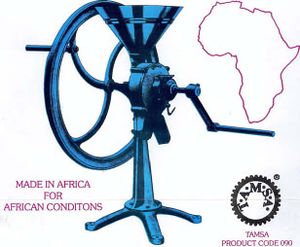
Depending on their purpose, we manufacture various types; for Europe, these are generally wheel mills for poultry feed, this feed only requiring to contain a minimum of of fine particles. It is the opposite for the manual mills that turn grain into flour. The different grinding fineness depends for the modification on the following design parameters:
- Disc diameter
- Type of grooves in the discs
- Using a pre-crusher (or multiple passes)
A finely grinded material is obtained by large discs, with fine grooves and by using a pre-crusher, the latter being primarily required for milling maize grains that are big and hard. The comparison between tables 2 and 4 (a, b, c) shows that the index of smoothness is almost always smaller than the flour produced by the traditional processes.
Attempts have been done in Africa to use these small capacity mills in households, and not a with communal services. These tests have resulted in failures. This, not because of the price of these devices, but mainly because of the fact that, in order to obtain a fine meal that is equivalent to that obtained with a mortar and pestle, it is necessary to perform two or three passes at the mill. The expenditure of time and energy is larger than that of the traditional grinding. Table 5 summarizes the hand mill projects that have failed. In fact, many of these mills have been recovered for other uses, like grinding dried chilli or for preparing animal feed.
There are also manual mills equipped with larger wheels (20 cm). Their throughput up to 20 to 40 kg/h. But thir price reaches that of the small motorised mills (eg the NOVA + manual available at Deklerk-Bexen); about 1000-1500 €.
A. "Atlas No. 1" (Hunt) mill
| Location | Matter to grind | Number of milling passages | Number of people | Quantity | Average yield per person | Fineness index |
| Douala (Madagascar) | Maize | 3 | 3 men | 1.3 kg/20 min | 1.3 kg/h | 1.61 |
| Douala (Madagascar) | Cassava | 1 | 3 men | 2 kg/20 m | 2 kg/h | |
| Bangui | Cassava | 1 | 3 men | 2 kg/15 min | 2.7 kg/h |
B. "Atlas No. 3" (Hunt) mill
| Location | Matter to grind | Number of milling passages | Number of people | Quantity | Average yield per person | Fineness index |
| Sarh (Chad) | Millet | 1 | 4 men | 3.5 kg/23 min | 2.3 kg/h | ? |
| Sarh (Chad) | Sorghum | 1 | 2 boys | 3.1 kg/37 min | 2.5 kg/h | 1.28 |
C. "Criquet 2" (Moulis) mill
| Location | Matter to grind | Number of milling passages | Number of people | Quantity | Average yield per person | Fineness index |
| Zole (CAR) | 1 | 1 boy | Sorghum | 0.4 Kg/18 min | 1.3 kg/h | 1.56 |
| Zole (CAR) | Maize | 2 | 1 male | 0.17 kilograms/4 min | 2.5 kg/h | ? |
Tables 4a, 4b, 4c: hand mills testings. After "David Livingstone Institute Series on Choice of Techniques in Developing Countries, volume 1: Brewing in Developing Countries, J. Keddie & W. Cleghorn, Scottish Academic Press, Edinburgh, Scotland, 1979, 134 p., ISBN: 7073-0240-3"
| Country | Institution | Contact | Period | Mill types | Main reason of failure |
| Cameroon | INADES Maroua | Father Gonzaga | 1970 | ? | Work too hard for women |
| Cameroon | Baptistische Missie Mokong | Heinz Hahnenstein | 1972/73 | ? | Work too hard for women. Men asking too high wages because of the hard work |
| Cameroon | Katholische Missie Koza | 1980 | Hunt n°3 | As soon as the motorised mill was available, the hand mill was no longer used, exept if its use was free-of-charge | |
| Chad | Professional agricultural training centers | Reto Zehnder | 1983 | Hunt n°3 | One of the two mills is used 1,30 hours a day, the other not at all |
| CAR | Rural animation (Catholic missions) | Sister Simone | 1984 | Hunt n°3 | 18 mills purchased, most no longer used. Reason: inappropriate for milling cassava |
Table 5: Overview of aborted hand mills projects. After "David Livingstone Institute Series on Choice of Techniques in Developing Countries, volume 1: Brewing in Developing Countries, J. Keddie & W. Cleghorn, Scottish Academic Press, Edinburgh, Scotland, 1979, 134 p. ISBN: 7073-0240-3"
Motorised mills: popular but expensive The wheel mills are often equipped with a an electric or an internal combustion engine with 3.5 to 8 horsepower. There are also models that can be connected to the 3-pint hitch of a tractor vehicle.
The engine power varies depending on the type and size of wheels, and the speed and fineness of the desired flour. The speed is in the range of 600 rpm for metal wheel mills and 400 to 500 rpm for corundum wheel mills.
Amongst the metal wheel mills, Hunt (model 1A or 2A) and Bentall are very common brands. But at the moment, more and more often, and sometimes even only their Indian (Amuda) or Tanzanian replica are found to be cheaper.
But these mills are difficult to build, especially the grinding control system, and very few local artisans are engaged in their manufacturing. While expensive in purchase, their maintenance is also more complex and costly than hammer mills. Also, these latter are also more successful than the wheel mills.
As already mentioned, the natural stone or corundum wheel mills do not have the versatility of the metal wheel, but do produce better quality flour. Also, we see them appearing mostly in town, where the consumers are more demanding.
Precise results (fine flour, power requirements, speed,..) of the performed tests on motorized wheel mills are given in comparison paragraph of wheel and hammer mills.
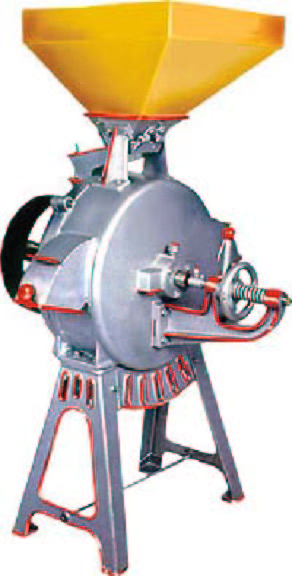
The animal-driven mill This type of mill is an intermediate technology between the manual methods (pestle and mortar, hand-mill) and the motorised mill.
Several models have been developed, notably by UNAT in cooperation with Sheikh Gueye (test results and construction details available in "Improvements and cost reducing changes on a treadmill (MATA: Moulin à Traction Animale), Peeters L., van der Valk R.E., Prot F., UNATA Research and Development, Aarschot, 1994, 26p.)", and by I.T.Dello (Institut Technologique Dello) in collaboration with the Relais Technologique ENDA and two African artisans: Cheikh Gueye (Gossas in Senegal) and Paul Nikiema (Ouagadougou, Burkina Faso).
These animal-driven mills can be completely manufactured on site by artisans/mechanics, except for the wheels that often need importing. Experience obtained in the Sahel shows that a few weeks training is sufficient to even put a well qualified craftsman to work in building mills independently at the stable. A critical condition is the availability of materials for welding and the mastering thereof.
The model succinctly presented here is made by I.T.Dello.
The modus operandi is simple. The animal-traction stable drives a wheeled mill. The donkey, horse or mule running around a wall upon which a wheel is mounted. When the animal moves forward, the wheel is driven and generates a rotation to the axis of movement. A transmission system with chains and sprockets permits to drive, with a multiplied speed, the axis of the mobile wheel mill (see image 15).
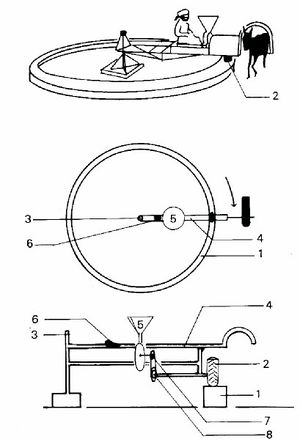
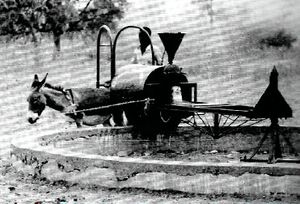
This construction, unusual at first glance, has the advantage to only need one operator, who is seated on a chair placed next to the mill, where he can simultaneously monitor the animal as well as the mill, and set the spacing between the wheels and collect the flour.
The throughput is around 10 to 20kg/h. This throughput rate is an average rate and does not include the resting time of the animal. There also find more large variations, notably arising from:
- The nature of animal: horse or donkey (lower number of turns for the donkey; typically 2.5 rpm, for the horse, up to 4 rpm).
- The physical condition of the animal: fatigue, poor nutrition (especially during the dry season).
- His caracter (poorly trained,...).
- The moisture content of the grain.
- The settings of the space or the pressure between the wheels.
- The settings of the opening (more or less); regulated by the component located at the base of the feeding sieve (see Improvements and cost reducing changes on a treadmill (MATA: Moulin à Traction Animale), Peeters L., van der Valk R.E., Prot F., UNATA Research and Development, Aarschot, 1994, 26p.)
- Transmission change connection (typically 10/1 for the first gear, and 5/1 for the second).
- The diameter of the used wheels.
Table 6 shows different results, allowing the estimation of the flour fineness, depending on the speed of rotation of the mill and the pressure between the wheels (220 mm in diameter), the first gear being near to 10/1, the second gear being close to 4/1. These tests were done with hulled millet. This table shows for each speed and pressure, the refusal percentages for sieves of 110 and 240 mails/cm² and the rest passes the finest sieve (240 mailles/cm²).
| Pressure between the wheels (kg/cm2) | Rotation speed of the mobile wheel (rpm) | Refuse with a 110 mails/cm² sieve in % of milling weight | Refuse with a 240 mails/cm² sieve in % of milling weight | Passings with a 240 mails/cm² sieve (in %) |
| 0.1 | 50 | 61 | 28 | 10 |
| 0.1 | 80 | 44 | 37 | 19 |
| 0.1 | 125 | 30 | 50 | 19 |
| 0.1 | 200 | 23 | 53 | 23 |
| 0.1 | 500 | 10 | 56 | 33 |
| 0.12 | 50 | 37 | 46 | 17 |
| 0.12 | 80 | 13 | 48 | 18 |
| 0.12 | 125 | 21 | 48 | 30 |
| 0.12 | 200 | 23 | 50 | 26 |
| 0.14 | 50 | 22 | 56 | 21 |
| 0.14 | 80 | 12 | 48 | 40 |
| 0.14 | 125 | 1 | 53 | 46 |
| 0.14 | 200 | 0 | 60 | 40 |
| 0.15 | 125 | 5 | 29 | 65 |
Table 6: Results of different tests with a horse-drawn mill. After "Mouture de céréales par manèges à traction animale: expérimentation de prototypes de moulin manège au Burkina Faso et en France – Rapport technique, Sarda J., Institut technologique Dello, Verberie, France, 1985, 58 p.
The cost of such a mill in 1986 ranged from 350 000 to 370 000 Franc CFA (today, this equates to approximately 700 000-720 000 Franc CFA; see Appendix 1 on the history of the CFA franc). At the start of the project, imported mills were adapted for use with animals. But soon the mill was made locally, it was better adapted to local conditions (easier cleaning, better ejection of the flour). Only the wheels were still being imported.
Plans for the construction of this animal-driven mill are provided at the documentation, in parallel with this document.
We may conclude that, due to its modest throughput, the animal-driven mill is not designed to replace motorised mills, but it is a good alternative in:
- isolated rural regions, that experiencing difficulties in obtaining fuel and spare parts
- small villages and sparsely populated areas where the number of users is too small for a motorised mill to be cost-effective
- areas where animal traction is already used and where they seek to make a profit from their beasts of burden
The watermill These are essentially wheeled mills driven by a waterflow. Typically, horizontal wheels are used. These mills are commonly used in the highlands of East Africa, in the Himalayas and in the Andes, which all have many fast rivers. Image 17 shows the cross section of a wheeled mill motorised by a river.
The current, which must have a minimum flow of 500 l/s, turns a wooden paddle wheel that drives the upper wheel using a vertical wooden axis. This wheel rotates at a speed of about 120 rpm, the lower wheel is stationary.
The grain comes in through a feed hopper (whose outlet has approximately a diameter of 15 cm), at the center of the upper wheel of which the rotation drives it to the periphery during the milling. Grooves carved in the wheels promote the movement of the grain, their depth gradually decreasing from the center to the periphery, the grain is thus milled in increasingly finer particles. The products of the milling are collected in an outside gutter, the fineness of the flour can be adjusted by the spacing of the wheels.
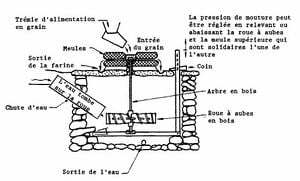
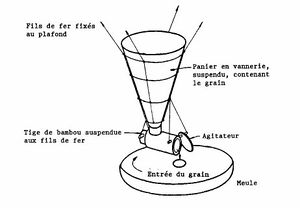
The watermills, equipped with wheels of 75 cm in diameter, produce 25 to 50 kg of flour per hour, depending on the desired degree of fineness (after "Production de farine de maïs à petite échelle, Bureau international du Travail, ONUDI, Genève, 1990"). The rotation speed of the wheels itself in function of the water flow.
Water mills can be built by local craftsmen from on site materials. As for the wheels, they can either be manufactured and cut on site or, more commonly, imported.
Very little data is available on these mills that you one encounters only rarely.
D. Power and speed The power absorbed by a wheeled mill depends on the following parameters:
- the grain feed rate: the power required can vary by 300% depending on the desired flow. For example, a mill can be powered by 3 HP or upto 6-7 HP. However, the theoretical flows are always lower than the actual flow.
- the rotation speed of the mobile wheel: if this is higher than the speed proposed by the manufacturers, we obtain a higher rate but a less homogeneous grinding. Furthermore, rotational speeds that are higher than the speed proposed by the manufacturers may lead to an
overheating of the obtained flour, which decreases its shelf-life. The speeds offered by manufacturers are average speeds: one can reduce it in order to improve the quality of the milling or increase it in order to increase the throughput. It is advisable that these changes do not exceed 25%.
- the diameter of the wheels: generally, larger wheels require a large supply of power.
- the number of wheel grooves: a greater number of grooves also allows a higher throughput.
- the spacing of the wheels: at an equal throughput, the closed wheels require tremendous supply of power.
- the nature of the products to grind.
- the moisture content of the cereals: a moisture content above 10 to 15 percent significantly reduces the throughput. The grain moisture causes sealing of the rollers (clogging of the grooves) and reduced the throughput. The metal wheel mills are designed to avoid such inconvenience.
E. Comparative summary
| Manual | Motorized | Animal-powered | Water-powered | |
| Throughput | +/- 10 kg/h | +/- 350 kg/h (25kg/h/HP) | 10 to 20kg/h. | 25 to 50 kg/h |
| Rotation speed of mobile wheel | 350 rpm | 300-900 rpm | 100 to 200 rpm | 120 rpm |
| Price | 70,000 - 200,000 Francs CFA | 1500000 Francs CFA (electric engine) | ~700,000 Francs CFA |
Table 7: Comparison of wheel mills.
The hammer mills[edit | edit source]
Chronologically, the hammer mills have emerged after the (high speed) motorized wheel mills. The rotation speed ranges indeed differ significantly between the two different types of mills, from 200-1200 rpm for wheel mills and 2500-6000 rpm for hammer mills, this speed does not allow a manual, nor animal-driven drivetrain.
The main advantages of the mill are its efficiency and ease of manufacture, allowing easier local construction; numberous are the artisans to produce it locally. Moreover, maintenance is easy and inexpensive.
Its main drawback is its lack of versatility: oilseeds are generally poorly tolerated, as is too wet grain, which clogs the grates. However, all dry grains and dried legumes (beans, soy seeds,...) and other dried goods (shells and even bones) may be grinded without difficulty, using a grid adaptation.
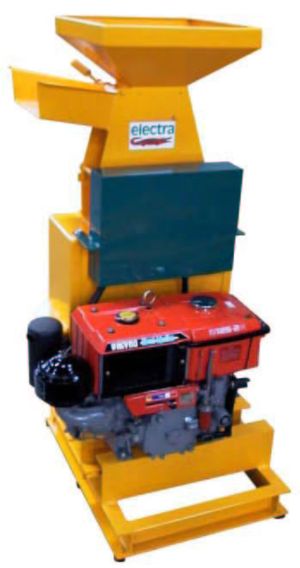
A. Principle of operation
The principle of operation is the grinding by pulverisation: the grain is pulverised by projecting it at high speed against the walls of the grinding chamber, in which a rotor with fixed hammers turns. The products (flour, meal) are released through a grid (or mesh) at the base of the grinding chamber.
B. Components
The grinding chamber
The interior of this chamber should not be totally smooth, so that the grain, manipulated by the hammers, encounters enough obstacles to be pulverised. These obstacles can be fixed counter-hammers, shock- or wear-plates on the walls laterally of the grinding chamber.
The hammers
Their role is to strike the grain and provide them with a rotation speed that is high enough for them to pulverise against the walls of the grinding chamber. The effectiveness of the hammers is increased by the multiplication of the angles of attack. In general, the hammers are reversible, that is to say that we can turn them back, so as to change the working parts, which increases their lifetime (see image 21).
The hammers can also be fixed or mobile. The first are firmly attached to the rotor, while the latter can rotate around their fixation axis (see image 22).
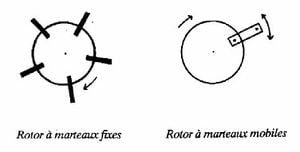
The advantage of the rotor with fixed hammers is its ease of construction. However, if a foreign body passes the grinding chamber by accident, it will create more damage than when the hammers were mobile, or they "fade" in passing.
The reversible hammers may grind an average of 450 kg of grain before being changed (after "Du grain à la farine: le décorticage et la mouture des céréales en Afrique de l'ouest, François, M., GRET").
The grid
Its role is to pass only fine enough particles, ie whose diameter is smaller than the diameter of the grid perforations. Depending on the desired particle size, this perforation diameter can vary from 0.5 to 3 mm, and even up to 5 mm for maize with large broken grains. The diameters larger than 1 mm are used for the production of meal or broken rice. The diameters of less than 1 mm are used for bread flour (0.5 mm) or rolls flour (granulation of the flour: 0.7-0.8 mm) for granulated products, like couscous, for example.
The carcass
The carcass is made up of the grinding chamber, the hopper and the feet. It can be cast or made from sheet metal parts, assembled together by welding and mechanical assembling.
Cast carcasses give an inertia to the whole, keeping down the vibrations which are the cause of cracks in the weakest parts of the motor and grinder. Moreover, the soundproofing is better. However, cast iron is a brittle material and the disadvantage of this is that it breaks or cracks easily, the repairs are difficult because we cannot perform welding on cast iron.
The assembled metal carcas mills are more likely to vibrate and are less well soundproofed. In return, they have three significant qualities: lightness and therefore the ease of transport, the overall lower price, and finally, the benefit of local manufacturing and repair.
C. Performance
Rotation speed and power
The speed of rotation of the hammers must be at least 1500 rpm, an engine is mandatory. Below this speed, grinding is no longer possible because the grains are not thrown against the walls with enough speed to be pulverised.
In general, the rotational speed is 3000 rpm. Some manufacturers (notably Electra) use a speed up to 6000 rpm, the obtained flour can then be very fine, but the energy expenditure is increased.
The power supply, in turn, can vary from 5 to 15 hp, the 9-11 hp range being the most common.
Throughput
The throughput is influenced by various factors:
- The grid:
- The larger the diameter of the perforations, the higher the speed is, but the less fine the flour is
- The more holes per m2, the greater the throughput.
- The thinner the grid is, the higher the throughput, but the the more fragile the grid is
- The humidity contence:
- The humidity contence is a factor that strongly determines the throughput: a 1% increase in moisture contents causes a throughput decrease of 10%. On the other hand, too wet seeds clog the grid and stop the functioning of the mill. The humidity contents depends on the maximum diameter of the grid perforations.
- The engine power and the rotation speed of the hammers:
- these two factors can also influence the throughput. More higher the speed, the more the throughput increases. For flour, the hammer rotation speed is recommended to be between 3500 and 4000 rpm, it drops to 1800 rpm for meal.
- The nature of the product to grind: a contents of fat and sugar that passes a certain threshold (5 to 8 per cent) may cause clogging of the grid.
Overall, the efficiency is most often between 150 and 400kg/h.
In general, the flow can be significantly affected by these factors. It should therefore take the rates advertised in the documentation of the manufacturers very carefully into account. Are they obtained for a coarse grinding, for meal, for flour? Dry or slightly humid ? With which engine power?
D. Artisanal manufacturing
One advantage of the hammer mill is that they can be manufactured locally in workshops equipped with welding stations, using the available materials in urban environments and most rural areas. Artisans manufacture them in all the countries where they have been imported. Often, artisans are more available than personnel of import firms, they can devote more time to train villagers and they also ensure a monitoring specifically to devices.
This type of mill is affordable, easy and inexpensive to maintain. However, in the case of a diesel engine, the cost is high and the maintenance is difficult. The possibility of local manufacturing, and therefore maintenance and repair, the ease of regulation, the regularity of flour, the lower cost of purchase and the maintenance are the main strengths of this type of mill. Its main drawbacks are, as already mentioned, its higher energy consumption and low versatility; oilseeds and very wet grains are poorly tolerated.
E. Special case: the bicycle-mounted mill and the pedalling grinder
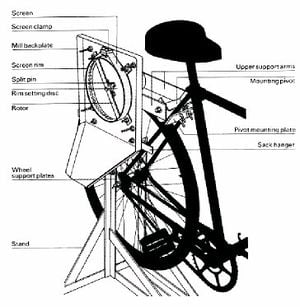
These mills have been developed by the TDRI, Tropical Development Research Institute, England.
These two devices (see image 23) are both very similar. In the first case, the mill is mounted on a bicycle, while in the second case, the bicycle has been replaced by a wooden frame.
The mill itself is based on a principle which is very similar to the conventional hammer mill. The operator pedals at a "normal but still supported" speed. The wheel then drives the axis of the mill at a speed of 5000 rpm (which corresponds for operator to a speed of about 25 km/h). An arm (hammer, or "rotor", see image 24 below) is attached to this axis and the grain is grinded when struck by the end of this arm. A easily removable grid (or "screen" in image 24 below), allows one to choose the fineness of the flour depending on the desired size of the meshes. For a given effort, the throughput depends on the desired fineness. According to TDRI, the mill works best for hard and brittle grains like maize, millet, sorghum and soybeans.
-
Bicycle-mounted mill and pedalling grinder. After "A pedal-operated grain mill, Rural Technology Guide 5, Pinson G. S., Tropical Products Institute, London, 1978, 32 p., ISBN : 0-85954-076-6"
-
Construction details of the drivetrain of the grinder. After "A pedal-operated grain mill, Rural Technology Guide 5, Pinson G. S., Tropical Products Institute, London, 1978, 32 p., ISBN : 0-85954-076-6"
About these mills, it is worth noting the following (after "Traitement des céréales, UNIFEM, New-York, USA, 1989, 75 p., Coll.: Manuel de technologies du cycle alimentaire, n° 3 , p.35,), a case study in Tanzania:
- The TDRI mill was originally designed to be used on the bicycles of the villagers. But if they do have bicycles, they can not use the mill. To proceed to the testing, bicycles have been provided. The results were not satisfactory because the villagers believed that for the grinding of the maize they had wasted a good bicycle. They removed the mill and used the bike for other purposes. It is important to note that the shelling of the grain is a task for the women and that the men do not see the need to facilitate their work using a bicycle.
- Women were generally not prepared to use a bicycle. Traditionally, it are the men who use them and the villagers were embarrassed to use this device. They were so reluctant to use bicycles, that some even put themselves on their knees to turn the pedals by hand.
- We attempted to circumvent these social difficulties by introducing a pedal mill mounted on a wooden frame made by the Arusha Appropriate Technology Project. But this initiative failed because the frame was not strong enough and it was very uncomfortable when pedaling.
- Neither TDRI models are still used today, and the villagers seem to show no interest in pursuing this experience. The quality of the flour produced by the mill is quite satisfactory, but the efficiency is very low. Again maize is the most difficult grain to treat and it requires two or three grindings. It takes 2 to 4 hours to produce one kilo of maize flour.
It showed that the TDRI mills were not appropriate for Tanzania. "
The list of equipment, as well as the plans and the construction stages of the mills are available in the reference No. 21 and in the documentation provided in conjunction with this document. Unfortunately, no information is given on the quality of the obtained flour, throughput and the average price of construction.
References[edit | edit source]
- ↑ The standard for the manufacturing of American sieves has been used for determining the fineness index

